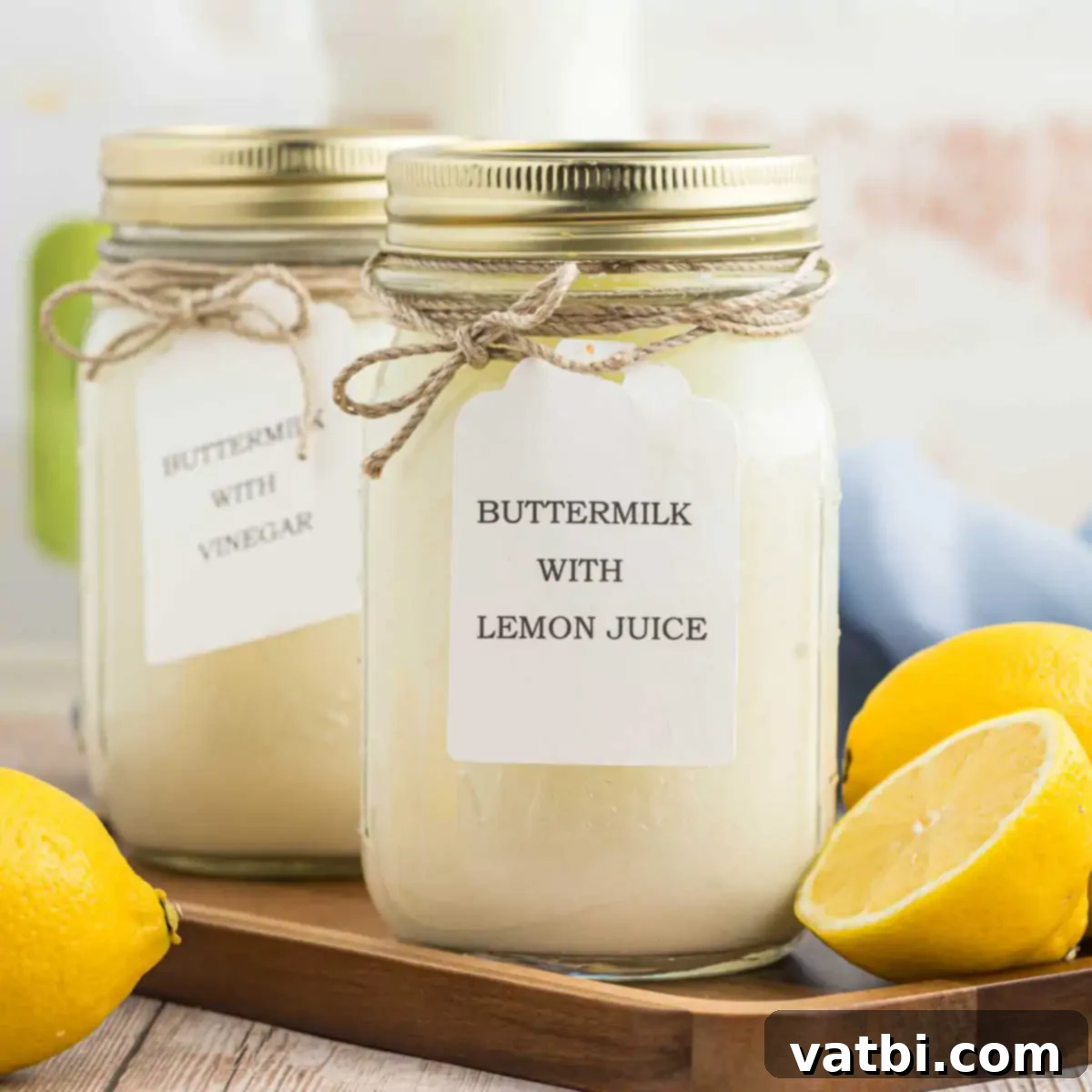The Complete Guide to Buttermilk: What It Is, How to Make It, and Its Culinary Magic
Buttermilk, with its distinctive tangy flavor and wonderfully smooth texture, stands as a versatile and beloved ingredient in kitchens worldwide. Far more than just a by-product, it’s a unique dairy product that lends its special qualities to an astonishing array of cooking and baking recipes. If you’ve ever glanced at an ingredient list calling for buttermilk and wondered, “What exactly is buttermilk?” or “Can I make this at home?”, you’re in the right place. This comprehensive guide will answer all your questions, demystifying buttermilk and empowering you to harness its full potential.
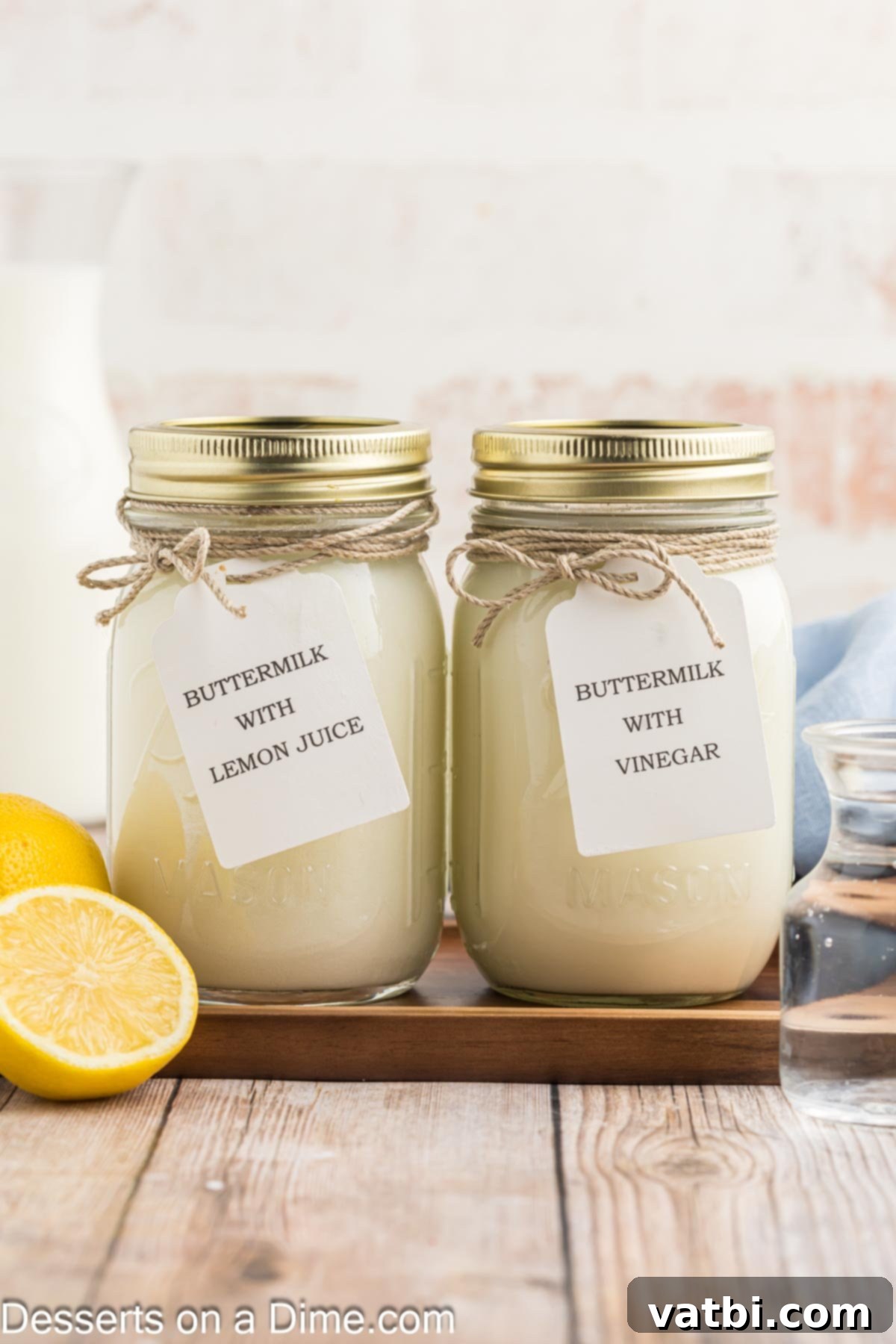
From creating the perfect tender crumb in baked goods to acting as a tenderizing marinade for meats, buttermilk is a cornerstone ingredient for many delicious dishes. Imagine the light and airy texture of Texas Sheet Cake Bites, the rich depth of a Red Velvet Pound Cake, or the moist perfection of the Best Vanilla Cupcake Recipe – buttermilk is often the secret ingredient behind their success. Beyond sweets, it transforms savory dishes too, making homemade ranch dressing wonderfully creamy, Fried Chicken exceptionally juicy and crispy, and buttermilk biscuits unbelievably flaky and flavorful.
Prepare to uncover the culinary magic of buttermilk, and you’ll be pleasantly surprised at how effortless and rewarding it is to make your own at home. Once you understand its properties and simple preparation, you’ll wonder how you ever cooked without it.
Table of contents
- What is Buttermilk?
- Ingredients You Need to Make Homemade Buttermilk
- How to Make Buttermilk at Home
- The Versatile Power of Buttermilk in Your Kitchen
- Frequently Asked Questions About Buttermilk
- Popular Recipes Featuring Buttermilk
What is Buttermilk?
Historically, buttermilk was the thin, slightly acidic liquid left behind after churning butter from cultured cream. This traditional form of buttermilk, sometimes called “churned buttermilk,” was a natural by-product, possessing a subtle tang from the fermentation of lactose by beneficial bacteria present in the cream. While still available in some specialized markets, this isn’t what most people encounter today.
Modern or “cultured” buttermilk, which is now the most common type, is produced by a deliberate fermentation process. It involves adding a starter culture of lactic acid bacteria to low-fat or skim milk. These bacteria consume the lactose (milk sugars) and produce lactic acid, which increases the milk’s acidity. This acidity causes the milk proteins (casein) to curdle and thicken, resulting in buttermilk’s characteristic rich, viscous consistency and its signature tangy, slightly sour flavor. This process is very similar to how yogurt is made, though buttermilk typically has a thinner consistency.
The fermentation not only gives buttermilk its distinctive sour flavor and creamy texture but also makes it highly digestible for some individuals sensitive to lactose, as a portion of the lactose has been converted to lactic acid. Its defining acidity is what makes it an excellent and versatile culinary staple. This acidic nature reacts with leavening agents like baking soda, creating carbon dioxide bubbles that contribute to the light and airy texture of baked goods. Furthermore, buttermilk’s enzymes and acids help to tenderize proteins, making it an ideal ingredient for marinades and batters.
With its thick, yogurt-like texture and bright, refreshing tang, buttermilk is incredibly useful in a wide array of recipes. Its remarkable tenderizing and flavor-enhancing capabilities have made it an indispensable ingredient in baked goods, contributing to their remarkable lightness, moisture, and fine crumb. Beyond baking, buttermilk is versatile enough to serve as a fantastic foundation for various culinary and beverage applications, including robust salad dressings, tenderizing meat marinades, creamy dips, and even cool, refreshing drinks. Moreover, it’s often lower in calories than whole milk and is a good source of vitamin B12, calcium, and probiotics, making it a nutritious addition to your diet.
Given its widespread utility and the simple nature of its creation, it’s no wonder many home cooks choose to make their own. If you’re ready to try your hand at homemade buttermilk, I’ve included a straightforward guide below.
Ingredients You Need to Make Homemade Buttermilk
Creating your own buttermilk at home is surprisingly simple and requires only two common ingredients. You likely already have them in your pantry and refrigerator! The key is the interaction between milk and an acidic agent, which mimics the natural fermentation process of commercial buttermilk.
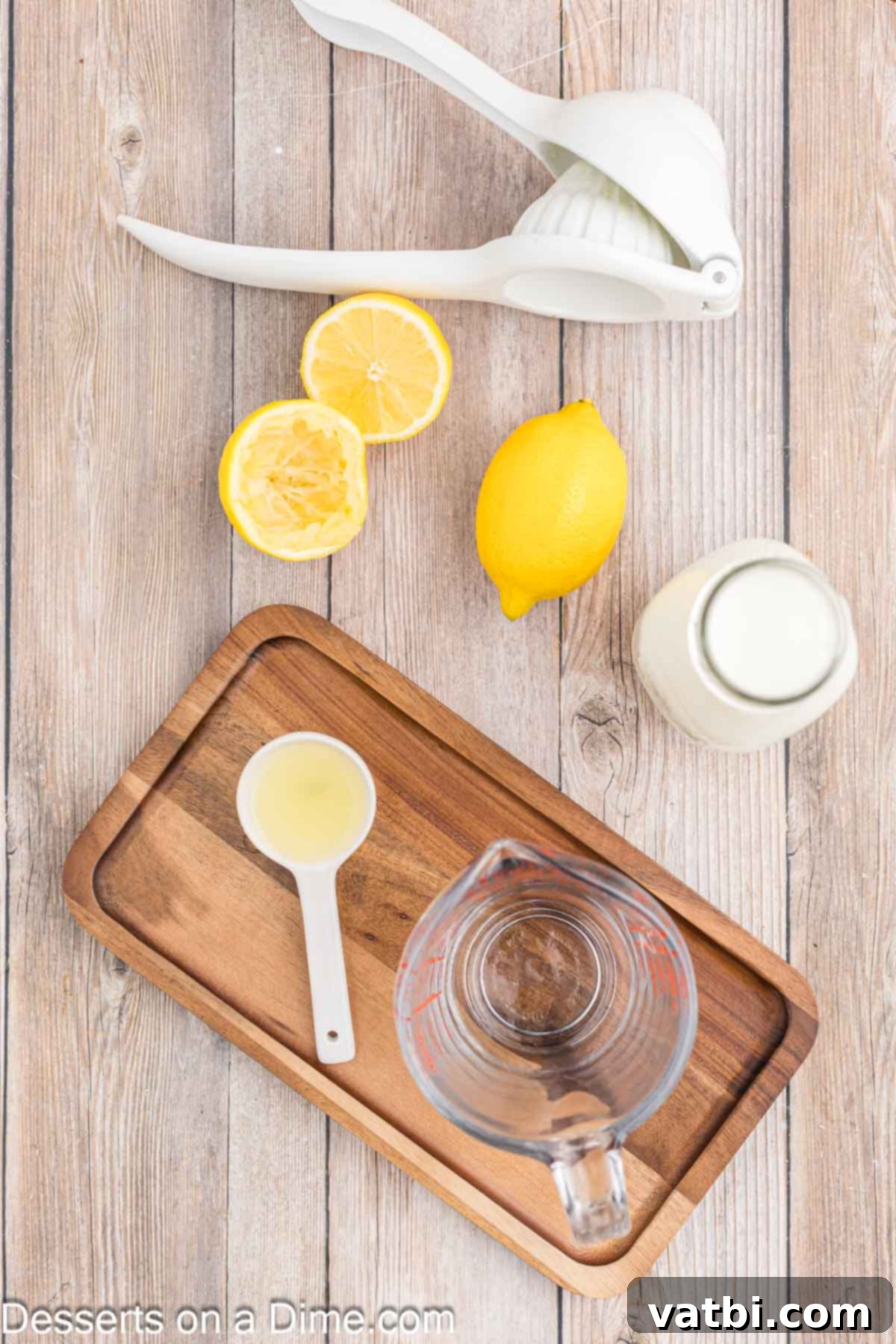
- Milk: You can use almost any type of milk for this method.
- Whole Milk: Will yield the richest, creamiest homemade buttermilk, excellent for baking.
- Low-Fat Milk (1% or 2%): A good all-purpose option that works well in most recipes and is closer in fat content to commercial cultured buttermilk.
- Skim Milk: Produces a thinner buttermilk, suitable for lighter recipes or beverages.
- Dairy-Free Milk: For a dairy-free alternative, plant-based milks like almond milk, soy milk, oat milk, or coconut milk (from a carton, not canned) can also be used. Ensure they are unsweetened and unflavored to avoid altering the taste of your final dish.
- Lemon Juice or Vinegar: This is your acidic agent that will curdle the milk.
- Fresh Lemon Juice: Provides a clean, bright tang. Freshly squeezed is always best for flavor.
- White Vinegar: A neutral-tasting and highly effective option.
- Apple Cider Vinegar: Imparts a slight apple-y note, which can be lovely in certain recipes, especially those with warmer spices.
- Lime Juice: Similar to lemon juice, it offers a distinct citrus tang.
The standard ratio is 1 tablespoon of acid per 1 cup of milk. This simple combination will create a perfectly suitable buttermilk substitute for most recipes, mimicking the texture and acidity needed for successful cooking and baking.
How to Make Buttermilk at Home: A Simple Step-by-Step Guide
Don’t have buttermilk on hand? No problem! Making your own substitute is incredibly easy and takes just a few minutes. Follow these simple steps to create a fresh batch of homemade buttermilk whenever a recipe calls for it.

Step 1: Measure Your Acid. Begin by grabbing a liquid measuring cup. Pour 1 tablespoon of your chosen acid—either white vinegar, apple cider vinegar, or fresh lemon juice—into the measuring cup. For optimal flavor, especially if using lemon juice, make sure it’s freshly squeezed.
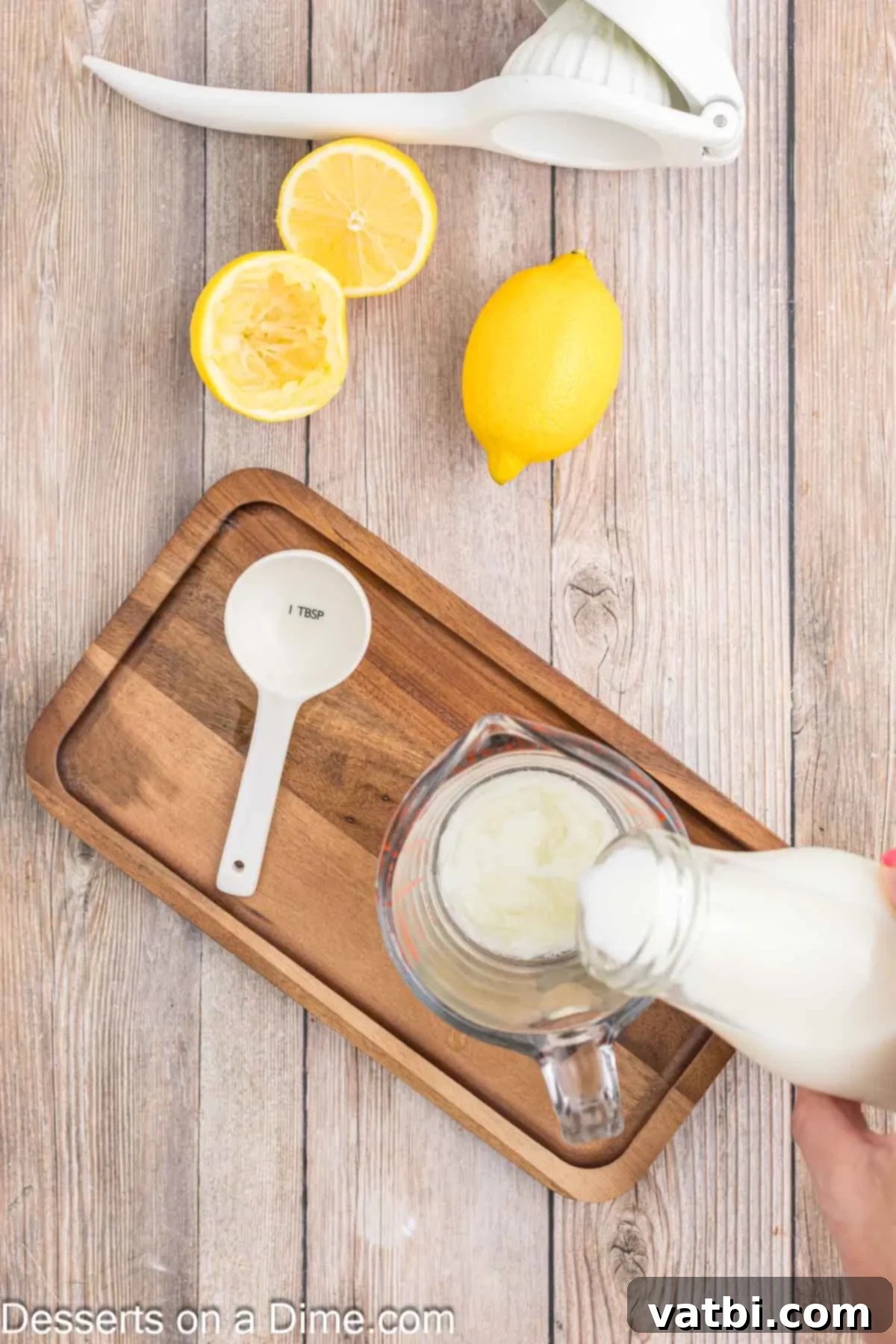
Step 2: Add the Milk. Carefully add 1 cup of milk (whole, low-fat, or dairy-free) to the measuring cup, pouring it directly over the vinegar or lemon juice. The acid will immediately begin to interact with the milk proteins, starting the curdling process.
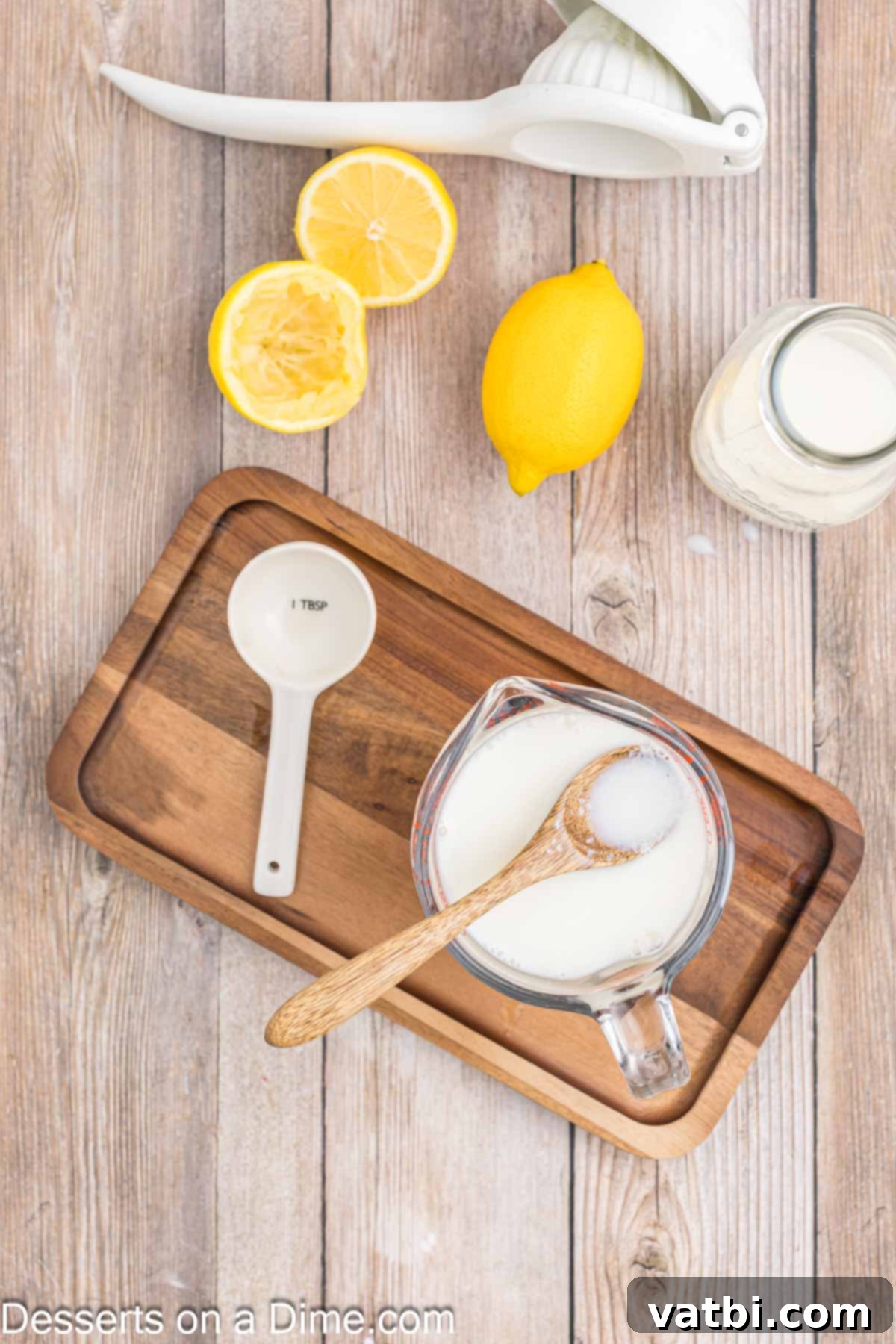
Step 3: Gentle Stirring. Use a spoon or small whisk to gently stir the mixture for a few seconds. This ensures that the acidic agent is evenly distributed throughout the milk, allowing for a consistent curdling process. You don’t need to stir vigorously, just enough to combine.
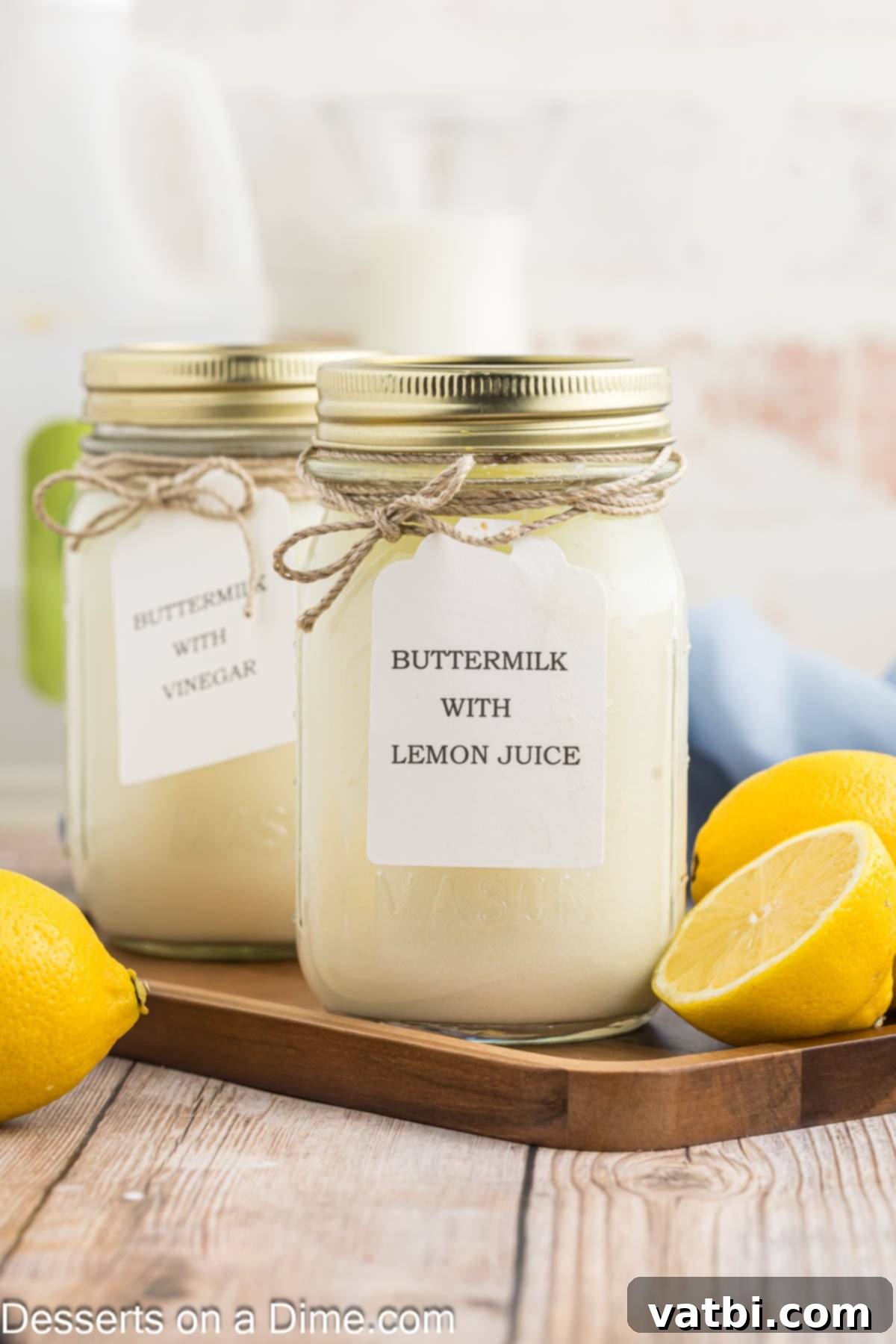
Step 4: Let It Rest and Thicken. Allow the mixture to settle undisturbed at room temperature for approximately 5-10 minutes. During this time, the acid in the lemon juice or vinegar will react with the milk, causing it to curdle and thicken slightly. You’ll observe small curds forming and the milk taking on a slightly more viscous consistency. When the 10 minutes are up, give the ingredients a quick stir once more. You’ll find that the consistency is now much closer to that of store-bought buttermilk. Your homemade buttermilk is ready to use! Pour it into a mason jar or other airtight storage container if not using immediately.
Your freshly made buttermilk is now ready to be incorporated into any recipe that calls for it. You can use it right away, or store it in the refrigerator for later use. Keep in mind that you can let the mixture sit for up to 20-30 minutes if you prefer a tangier flavor and a thicker consistency. However, 10 minutes is typically sufficient to achieve the ideal taste and texture for most baking and cooking applications. For best results, ensure your milk is at room temperature before starting, as this helps the curdling process along efficiently.
The Versatile Power of Buttermilk in Your Kitchen
Buttermilk is a true culinary MVP, transforming ordinary dishes into extraordinary ones with its unique properties. Its acidity and tang are not just for flavor; they play crucial roles in texture, moisture, and even browning. Let’s explore the many ways buttermilk can elevate your cooking and baking.
Buttermilk in Baking: Beyond Fluffy Pancakes
The acidic nature of buttermilk makes it a baking superhero, especially when combined with leavening agents like baking soda. When baking soda (a base) meets buttermilk (an acid), they react to produce carbon dioxide gas. These tiny bubbles are trapped within the batter, expanding during baking to create exceptionally light, tender, and airy textures. This is why buttermilk is essential for:
- Fluffy Pancakes and Waffles: It ensures a tender interior and a slightly crisp exterior.
- Moist Cakes and Cupcakes: Buttermilk tenderizes the gluten in flour, preventing toughness and contributing to a fine, delicate crumb. Red velvet cakes, in particular, rely heavily on buttermilk for their signature texture and subtle tang.
- Biscuits and Scones: The acid reacts with baking soda to create layers of flakiness and a tender crumb, while its slight tang complements the richness of butter.
- Quick Breads and Muffins: Ensures a beautifully risen, moist, and tender result without the need for yeast.
Buttermilk in Cooking: Enhancing Savory Dishes
Buttermilk’s utility extends far beyond the realm of baked goods, bringing its tenderizing and flavor-boosting capabilities to savory cooking.
- Marinades for Meats: The lactic acid in buttermilk acts as a gentle tenderizer for proteins, breaking down tough fibers without making the meat mushy (unlike some stronger acids like lemon juice or vinegar used alone). It’s perfect for chicken, pork, and even steak, infusing them with flavor and keeping them incredibly juicy. Fried chicken is a classic example where buttermilk marinade shines, creating a perfectly moist interior and a crispy coating.
- Creamy Salad Dressings and Dips: Its tang and smooth texture are ideal for creating rich, flavorful dressings like homemade ranch, blue cheese, or green goddess. It offers a healthier, lighter base than heavy cream or mayonnaise alone, while still delivering depth of flavor.
- Batters and Coatings for Fried Foods: Beyond fried chicken, buttermilk is excellent in batters for onion rings, fish, or vegetables. It adheres well, helps create a crispy crust, and its acidity adds a pleasant counterpoint to the richness of fried foods.
- Soups and Sauces: A splash of buttermilk can add a creamy richness and a bright, tangy finish to cream-based soups (like potato or broccoli cheddar) or gravies. It helps to cut through richness and adds a layer of complex flavor.
- Smoothies and Cool Drinks: For a healthy and refreshing boost, blend buttermilk into fruit smoothies. Its probiotics are a bonus, and its tang pairs well with berries or tropical fruits.
Truly, the combination of buttermilk’s tangy taste and smooth texture can do wonders for the flavor and consistency of your foods, making it an indispensable component in both sweet and savory culinary endeavors.
Frequently Asked Questions About Buttermilk
Like its store-bought counterpart, homemade buttermilk has a relatively short shelf life. The exact duration depends on several factors, including the initial freshness and quality of the milk used, the cleanliness of your containers, and proper storage conditions. When properly stored in an airtight container in the refrigerator, homemade buttermilk typically lasts for about 1 to 2 weeks. You’ll know it’s gone bad if it develops an off-odor, visible mold, or an excessively thick, lumpy texture beyond its usual curdling. For longer storage, homemade buttermilk can be safely frozen for up to 2-3 months. To freeze, pour it into ice cube trays for convenient portioning, then transfer the frozen cubes to a freezer-safe bag or container.
Baking with buttermilk is a fantastic way to infuse your baked goods with enhanced moisture, tenderness, and a delightful tangy flavor. In cakes, muffins, quick breads, and biscuits, it acts as a tenderizer by hydrating gluten less efficiently than water, preventing a tough texture. The slight acidity in buttermilk is crucial as it activates alkaline leavening ingredients like baking soda, initiating a chemical reaction that produces carbon dioxide bubbles. These bubbles contribute to a lighter, fluffier rise and a more tender crumb. Thus, buttermilk is an excellent ingredient to add to baked goods to make them moister, more flavorful, and beautifully textured, ensuring consistent, delicious results every time.
Buttermilk boasts a remarkably wide range of uses in savory cooking. It excels as a tenderizing marinade for meats like chicken, pork, or fish, imparting flavor and ensuring juiciness. Its tangy profile is perfect for crafting luscious salad dressings (such as ranch or blue cheese), creamy dips, and for spicing up batters and coatings for crispy fried meals with an irresistible zest. Beyond these, buttermilk adds a unique tangy twist to refreshing smoothies and shakes, makes pancakes and waffles unbelievably fluffy, and significantly improves the depth of flavor in creamy soups and sauces, helping to cut through richness. Its distinctive taste and smooth texture truly work wonders in enhancing the overall deliciousness of your culinary creations.
Absolutely! Making dairy-free buttermilk is straightforward. Simply substitute regular cow’s milk with your preferred non-dairy milk alternative. Excellent options include unsweetened almond milk, soy milk, oat milk, or even light coconut milk (from a carton, not canned due to higher fat content). The process remains the same: combine 1 tablespoon of an acidic agent (lemon juice or vinegar) with 1 cup of your chosen plant-based milk and let it sit for 5-10 minutes until it slightly thickens and curdles. While the texture might be slightly thinner than traditional buttermilk, it will provide the necessary acidity and tang for your recipes, allowing you to enjoy all the benefits of buttermilk without the dairy.
If you find yourself without the basic ingredients for homemade buttermilk, there are a few other quick substitutes, though they may not perfectly replicate the texture or flavor:
- Yogurt or Sour Cream Thinned with Water/Milk: Mix 1/2 cup plain yogurt or sour cream with 1/2 cup water or milk until it reaches a pourable consistency. This provides both tang and thickness.
- Cream of Tartar with Milk: For 1 cup of buttermilk, whisk 1 3/4 teaspoons of cream of tartar into 1 cup of milk. Let it sit for a few minutes. Cream of tartar is a dry acid, so it reacts quickly.
- Plain Kefir: Kefir is a fermented milk product very similar to buttermilk in tang and consistency, making it an excellent direct substitute.
Remember that the exact results may vary slightly depending on the substitute used and the specific recipe.
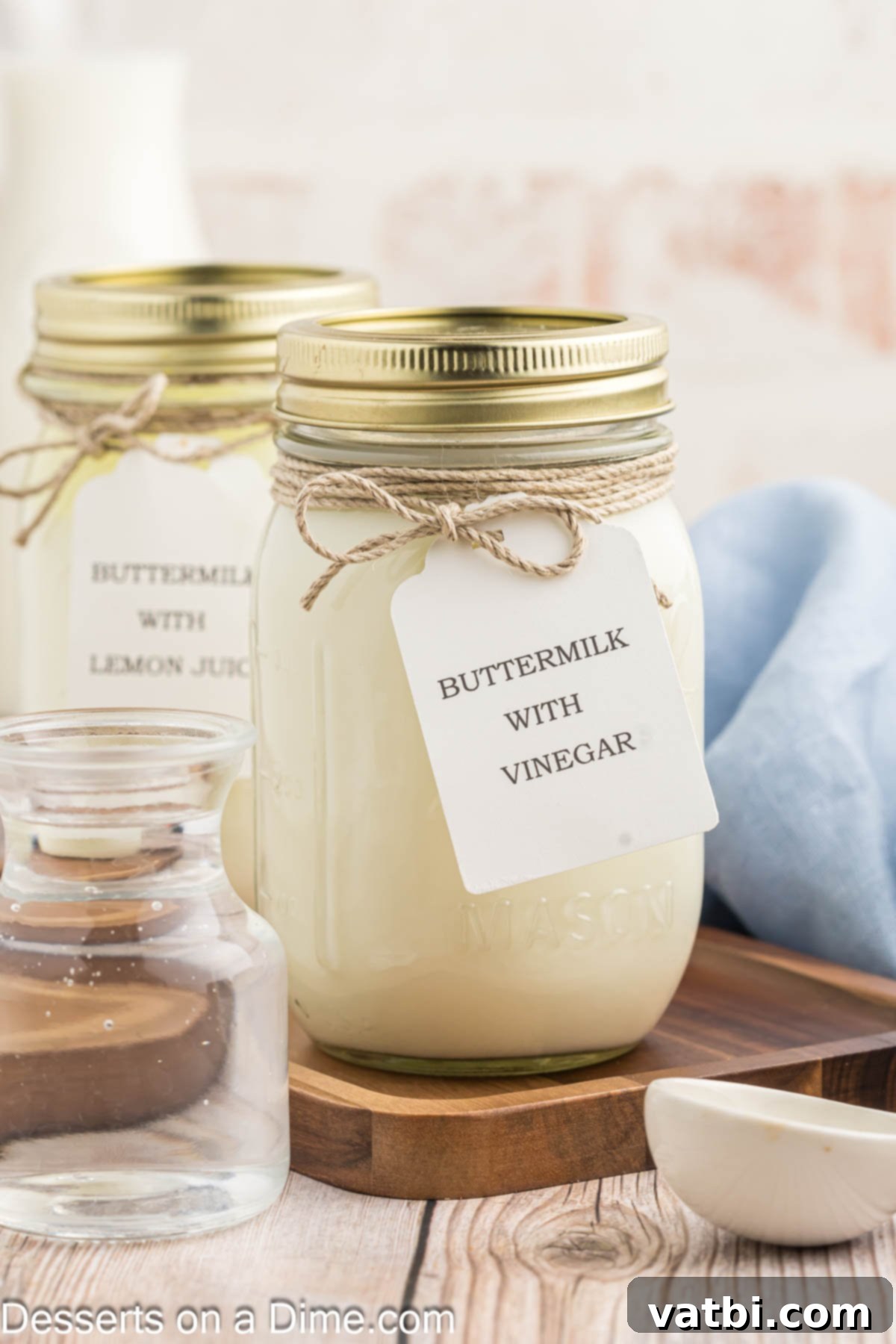
Popular Recipes Featuring Buttermilk
Now that you’re well-versed in the wonders of buttermilk and how to create it at home, it’s time to put your knowledge into practice! Buttermilk enhances a myriad of dishes, lending them unmatched moisture, tenderness, and a delightful tang. Here are some fantastic recipes where buttermilk plays a starring role, ensuring delicious results:
- Confetti Cupcakes
- Orange Crush Cupcakes
- Green Velvet Cupcakes
- Red Velvet Sheet Cake
- Lime Jell-O Poke Cake
- Banana Bundt Cake
Embrace the magic of buttermilk in your kitchen. Whether you’re whipping up a batch of fluffy pancakes for breakfast or a tender cake for dessert, you’ll find that this simple ingredient makes a significant difference. Try making it today and elevate your culinary creations. Please leave a comment and a star rating once you’ve experienced the goodness of homemade buttermilk!
